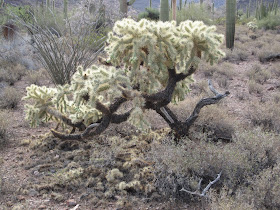The chain fruit cholla is also known as the hanging chain and jumping cholla. It is a tree-like cactus with one trunk from which grow branches and it can grow to a height of 12 feet or more, making it the largest of the cholla family. All of my pictures were taken in Organ Pipe Cactus National Monument in southern Arizona.
The chain fruit cholla is found in southern Arizona and northwestern Mexico at elevations between 1,000 and 3,000 feet. It has segmented branches that are light green
covered with a dense layer of silvery-yellow spines.
The spines help to reflect sunlight and prevent the cactus from over-heating.
As the cholla ages, the spines darken to a gray color (see the lower branches).
A close-up of the gray spines.
The spines eventually fall off, leaving a brown-black, rough, scaly bark on the trunk and oldest branches.
A close-up of the bark.
It blooms from June to August (I don't believe I've ever seen the blooms) with flowers that are white and pink, streaked with lavender. The flowers bloom at the end of branches and on old fruit. Following the wilting flowers, green, pear-shaped, fruit appear, about 1 1/2 inches long.
The fruit, in turn, produce flowers again the next year, adding additional fruit to those of previous seasons.
It is the hanging chains of fruit, sometimes up to two feet in length, that give it the names chain fruit and hanging chain cholla.
The flowers are pollinated by bees, but they more commonly reproduce when fruit segments drop to the ground and form roots, starting a new cactus. The ground around a mature chain fruit cholla will usually be covered by dead stems and young cacti generated from fallen stems.
A close-up of the litter beneath a chain fruit cholla, which, by the way, is deadly if you step on it in tennis shoes.
A young chain fruit cholla which has been generated from a fallen fruit.
Because the falling fruit does generate additional plants, they often form dense colonies.
The stems readily detach when brushed, giving the impression that the stem jumped. This is where the name jumping cholla comes from. Below, my pant leg with a chain fruit segment stuck in it and in my leg. This is one of the reasons I always wear long, baggy pants in the desert.
Passing animals will brush the segments on the cactus itself, or from the litter on the ground, and disperse it to other areas, another way in which the chain fruit propagates itself. The chain fruit is often the plant of choice for nesting cactus wrens. Between the litter on the ground and the web of spiny branches, the nest is well protected from predators, including man.
As even the bark sloughs off, I have seen the chain fruit continue to survive with part of its skeleton exposed.
Another picture of the spines and bark sloughing off and leaving the exposed wooden skeleton.
The fallen wooden skeletons are beautiful in their own right and add variety to the desert floor.
They are often found for sale in pet stores for use in terrariums.
Finally, a couple of additional pictures of chain fruit cholla.
They are one of the most interesting desert plants.























These things are painful. I had my first introduction a few weeks ago. Painful and educational!
ReplyDeleteShine-Southern Boy Meets Jumping Cholla!
I can still hear in my mind the screaming of several boy scouts that became too intimate with cholla. I recall one brother that actually threw some cholla at his brother and got him shrieking (these brothers had both spent time in juvenile hall and were a handful). Once you learn to be cautious and watchful around them you get great admiration for their evolutionary armor.
Deletewhat is the roots like
ReplyDelete